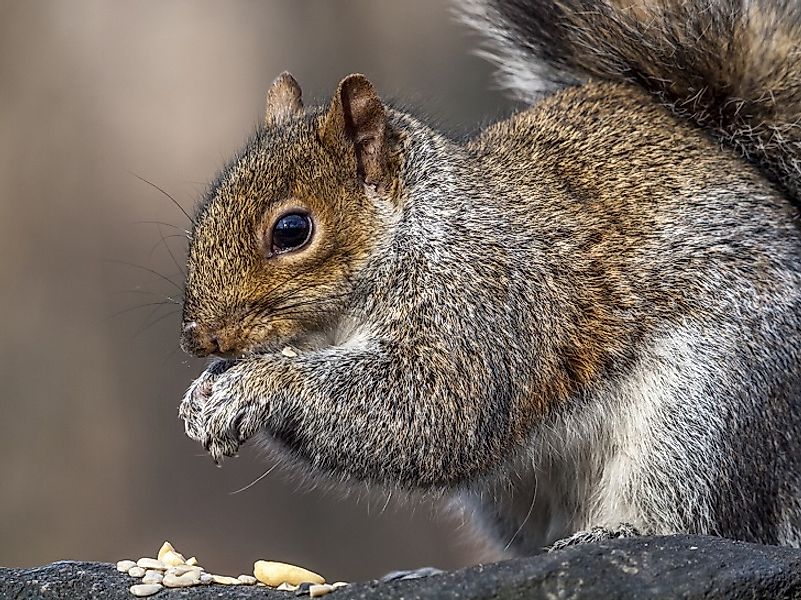Eastern Gray Squirrel Facts: Animals of North America

5. Physical Description
Like all squirrels, Eastern Grays are Mammals, in the Order Rodentia, Family Sciuridae. The binomial name Sciurus carolinensis loosely can be translated as “shadowed tail of the Carolinas”, referring to the rodents’ appearance and native lands. As their name implies, most Eastern Gray squirrels are characterized by the gray fur covering the tops of their bodies. This fur can also be more dark brown or, as in the case in much of the population in Southeast Canada, almost entirely black. “White” Eastern Gray squirrels occur more commonly in areas where fewer natural predators are present, as they are more likely than darker squirrels to be seen by predators, and often killed shortly after birth. Despite the color of their coats on their backside, most Eastern Gray squirrels have a white underbelly. Most Eastern Gray squirrels also have a characteristically bushy, black and gray tail, though it is often dismembered by human traps and predators. Adult Eastern Gray squirrels typically have body lengths between 9 and 12 inches when measured from head to tail base, and a tail length between 7 and 10 inches. Despite its small size, when running and hopping overland, its bounding stride may be up to three feet in length.
4. Diet
As reflected by their dental patterns, Eastern Gray squirrels are predominately herbivorous mammals. Nonetheless, they will also rarely feed on insects, bird eggs, and a variety of small animals, including reptiles, amphibians, and other rodents, even other squirrels, in times of food shortage. In the wild, their diets consist mostly of berries, flowers, nuts, seeds, tree bark, and fungi. Those living near human populations, however, will often steal a variety of exposed vegetables, fruits, and seeds from trash bins, bird feeders, and gardens. Squirrels are known for their hoarding prowess in storing food for lean times, and their acute memories allow them to accurately go back and find the food they have saved well into the future.
3. Habitat and Range
Eastern Gray squirrels have a wide range over which they have relatively dense populations. They tend to prefer living in hardwood forests, wherein they can most easily source their preferred diets. Eastern Gray Squirrels construct dens out of plant matter, and usually build them within the hollows of tree trunks or at the junction between large tree branches and tree trunks. They often will take up living in abandoned birds’ nests and dens of other squirrels and small rodents as well. Eastern Gray squirrels can be found across much of Eastern North America. The four edges encompassing their natural distribution could be said to be formed by East Texas in the southwest direction, a northward line from there to Manitoba, eastward to New Brunswick and Nova Scotia, back southward along the Atlantic Ocean to Florida, and then across the southern US Gulf shores to East Texas. Introduced to many corners of the world, invasive Eastern Gray squirrels have found their way into Europe in ship cargo and other ways, and have displaced native squirrel species in certain places there. While not used as such as often as other animals, the practice of hunting Eastern Gray Squirrels for their meat in not unheard of. Some individuals even keep them as pets, in the same manner as they would keep hamsters, mice, gerbils, and other rodents. Limits on squirrel hunting are minimal, as loss of predators due to hunting has left them overpopulated in many areas. Though they are subject to human activities that affect their lives, such as the felling timber and the use of poisonous agricultural chemicals, squirrels are extremely adaptable, and can be found frequently in backyards and city parks in close proximity to mankind. These reasons have made squirrels an animal of “least concern” in terms of becoming extinct in the near future.
2. Behavior
Squirrels possess apt communication skills that allow them to alert one another of the latest predatory dangers and food availability news, as well as to conduct mating rituals. With the exception of mothers and their young, communities of Eastern Gray squirrels tend to live near one another but dwell by themselves, though mates may often sleep together in cold weather. Squirrels are generally docile, but will become violent and fight for their lives when backed into a corner by predators or humans. Interestingly, squirrels are one of the few animals that possess the ability to descend a tree headfirst, likely a keen advantage in escaping predators.
1. Reproduction
Eastern Gray squirrels often breed twice a year, though younger mothers tend to have only one litter per annum. Eastern Gray squirrels are mammals that give birth to live young, and their gestation periods normally last 44 days, with their newborn weaned after 10 weeks. Shortly thereafter, squirrels will leave their mother’s nest. Eastern Gray squirrels enter sexual maturity in their second year of life, and may live as long as 20 years before dying of old age, though predation and disease usually make their lifespans much shorter. Squirrels must utilize their agile running and climbing abilities for survival, as they are choice targets for almost every manner of predatory large mammal and bird imaginable.











